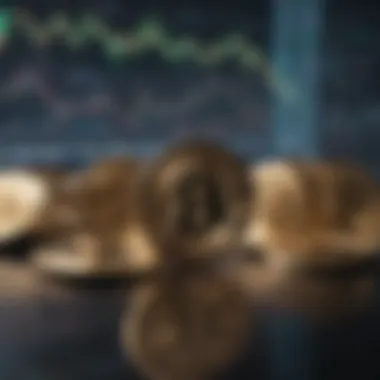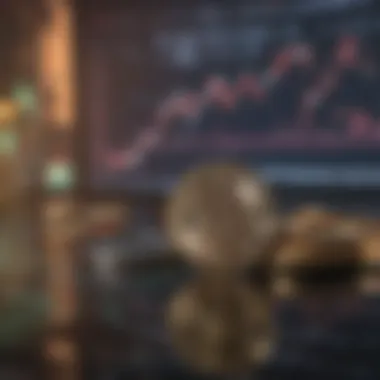Futures Trading Rules in Cryptocurrency Markets


Intro
Futures trading in the cryptocurrency markets is an increasingly popular option for investors and traders looking to navigate the volatile landscape of digital assets. With the rise of platforms offering futures contracts, understanding the underlying rules and strategies becomes essential. While the allure of high returns often captures attention, it’s crucial to grasp the risks involved and the mechanics that govern trading behaviors.
Cryptocurrency has attracted a wide array of participants, from seasoned investors to tech enthusiasts curious about the potential of digital currencies. The nature of futures contracts allows traders to speculate on the future price of cryptocurrencies, which can maximize opportunities for profit. However, without a thorough understanding of the rules and frameworks in place, one can easily experience the downsides of this trading format.
Regulatory oversight varies across regions, impacting how futures trading operates. While some countries have established comprehensive guidelines, others are still developing their approaches, leaving traders to navigate a complex maze of rules. Thus, proper diligence in understanding local legislation is paramount.
The following sections aim to unpack these various aspects of futures trading in cryptocurrency markets.
Market Analysis
Current Trends in Cryptocurrency
Currently, the cryptocurrency market is witnessing rapid transformations. Institutions have begun taking a more significant interest, which positively impacts market dynamics. Bitcoin, for instance, continues its gradual shift towards being viewed as a digital gold, prompting traders to take long positions in anticipation of price boosts. Moreover, altcoins are frequently emerging, each with unique proposals aimed at solving specific problems, changing the investment landscape further.
Traders are thus increasingly adapting their strategies - those who can anticipate trends often find themselves ahead of the game. This need for adaptability cannot be overstated; the market often reacts unexpectedly due to global news or regulatory developments. The recent entry of traditional financial firms into crypto futures shows the potential for mainstream integration, urging traders to refine their approaches.
Price Prediction Techniques
Forecasting price movements in cryptocurrency involves not just speculation but grounded strategies based on market data. A few effective techniques seen in the space include:
- Technical Analysis: This employs charts and historical data to predict future price movements. Indicators such as Moving Averages or Relative Strength Index provide critical insights, although they often require deep knowledge of market behaviors.
- Market Sentiment Analysis: Understanding trader sentiment through platforms like Reddit or Twitter is quite pivotal. Often, the emotional state of the market can create ripples that affect prices considerably.
- Fundamental Analysis: Assessing the inherent value of a cryptocurrency can also bring clarity. Important aspects here include the technology behind it, the team, its real-world applications, and any partnerships or endorsements.
Each of these techniques holds its strength and weaknesses. Often, a combination offers the best insights into potential price movements.
Investment Strategies
Long-Term vs Short-Term Investing
Deciding on an investment horizon significantly impacts strategies when participating in futures trading. Long-term investors tend to focus less on short-term price fluctuations and more on the fundamental growth of the cryptocurrency, intending to hold their positions through volatility. Conversely, short-term traders must be agile. Their strategies can range from day trading to swing trading, where timing is crucial.
Risk Management in Crypto Trading
Managing risk in futures trading is crucial due to the leveraged nature that amplifies both the potential for profit and the risk of loss. Key risk management practices could involve:
- Establishing Risk Limits: Clearly defined limits on how much capital one is willing to risk per trade.
- Utilizing Stop-Loss Orders: This can prevent excessive losses by automatically selling a position when it reaches a certain price.
- Diversifying Investments: Not placing all eggs in one basket and spreading investments across different assets helps mitigate risks significantly.
In essence, understanding the dynamics at play within futures trading in the cryptocurrency markets fosters a more strategic and informed approach. Armed with this knowledge, traders can enhance their decision-making processes and make their way through the oft-turbulent waters of crypto investing.
Intro to Futures Trading
In the fast-evolving world of cryptocurrency, understanding futures trading is akin to possessing a map in uncharted waters. This section illuminates the crucial elements of futures trading, creating a solid foundation for any investor or trader aiming to navigate the crypto seas. Exploring this topic equips readers with insights that are indispensable, particularly as market dynamics shift with dizzying speed.
Definition of Futures Trading
Futures trading involves contracts between two parties wherein one agrees to buy an asset at a predetermined price at a specific date in the future. Unlike simply buying assets outright, futures contracts allow traders to speculate on price movements without ever actually owning the underlying asset. The key aspect here is that these contracts are standardized, meaning they set out explicit conditions, like delivery dates and contract sizes, ensuring clarity in transactions.
In cryptocurrency, futures contracts can either be cash-settled or physically settled. Cash-settled contracts are compared against an index or reference price on the contract's expiry date, thus negating the need to transfer the underlying cryptocurrency.
Importance in Cryptocurrency Markets
Futures trading injects a dynamic element into the cryptocurrency market for various reasons:
- Price Discovery: It provides a mechanism for price discovery, as futures prices often reflect traders’ expectations of future price movements.
- Leverage Opportunities: Futures trading allows investors to control a larger position with a relatively small amount of capital through leverage. This means potential gains—and losses—can be significantly amplified.
- Hedging Mechanisms: Futures are utilized by businesses and investors to hedge against price fluctuations. For instance, a company that anticipates accepting cryptocurrency payment might use futures to lock in current prices.
Ultimately, understanding futures trading can empower individuals to make informed decisions and harness opportunities in the constantly changing cryptocurrency marketplace.
"Grasping the essence of futures trading could be the difference between sailing smoothly through market shifts and being tossed about in a storm."
By laying the groundwork here, investors and traders will find it easier to comprehend more complex concepts related to futures contracts and their profound implications in cryptocurrency transactions.
Basic Concepts of Futures Contracts
Understanding the basic concepts of futures contracts is essential for anyone aiming to engage in cryptocurrency trading. These contracts serve as the foundation of every future transaction, offering a clear glimpse into the mechanisms that drive market behaviors and pricing dynamics. Familiarity with these concepts brings clarity to the process of trading, enabling investors and traders to make informed decisions devoid of unnecessary confusion.
Futures trading usually involves commitments made today for a transaction that will occur at a future date. This allows traders to hedge against price fluctuations, participate in speculative trading, and manage risk effectively. Intricacies abound when it comes to how these contracts operate, each type offering different benefits that cater to specific trading strategies.
Understanding the Structure of a Futures Contract
A futures contract binds two parties to buy or sell an asset at a predetermined price on a specific future date. At its core, it is an agreement that lays out essential terms including the asset involved, the contract size, pricing, and expiration date.
The agreement is standardized, which means these contracts are traded on exchanges, ensuring transparency and liquidity in the market.
Moreover, each futures contract is marked by:
- Contract Size: Refers to the quantity of the underlying asset being traded. For instance, in Bitcoin futures trading, the contract size could represent a specific number of coins.
- Settlement Method: Most contracts can be cash-settled or physically settled, influencing how traders approach their positions as expiry approaches.
- Expiration Dates: Contracts must be closed or rolled over by a specific date, prompting a strategic approach to managing positions.
This structure not only guides traders through their activities but also sets the stage for advanced strategies and analyses.
Types of Futures Contracts
Futures contracts come in various forms, allowing different flexibilities and risk exposure. The most common types include Standard Futures Contracts, Mini Futures Contracts, and Trading Options on Futures, each catering to different trader preferences and risk appetites.
Standard Futures Contracts
Standard futures contracts are the well-known choice in trading circles. They represent a complete, full-sized contract usually reflecting a larger quantity of the underlying asset. This is significant for institutional traders, who typically prefer these contracts for their potential to realize substantial returns.
Key characteristics include:
- Priced for Bulk Transactions: These contracts allow traders to make larger positions with a standardized value.
- High Liquidity: Standard futures contracts tend to have more market participants, which in turn enhances liquidity and enables more substantial price movements.


However, the downside can be the need for more capital investment, which typically might not cater well to smaller, retail investors.
Mini Futures Contracts
Mini futures contracts are a more scaled-back version of standard futures. They allow traders to engage with the market without the extravagant capital that standard contracts require.
Key aspects worth noting are:
- Lower Capital Requirement: Mini contracts are perfect for novice traders or those testing risky waters without committing large sums.
- Flexibility for Smaller Traders: Retail investors find mini futures particularly appealing as they facilitate participation in the market without the risk of substantial losses.
The main drawback is that they may have lower liquidity compared to standard contracts, which could lead to wider spreads in buying and selling.
Trading Options on Futures
Trading options on futures adds another layer of complexity to the futures trading landscape. This allows traders the right, but not the obligation, to buy or sell futures contracts at predetermined prices.
This instrument introduces several advantages:
- Risk Management: Especially useful for hedging against adverse movements in the market without the pressure of facing losses outright.
- Flexibility: Traders can choose not to exercise the option when it doesn't work in their favor, unlike standard contracts where obligations are mandatory.
However, it also carries nuances that traders must navigate, such as the premium paid for the option, which may weigh on profitability.
In summary, understanding the types and structure of futures contracts equips traders with the essential knowledge to navigate the cryptocurrency trading landscape. As you will see, each type of contract plays a specific role in a trader's strategy, depending on their goals and risk tolerance.
Regulatory Aspects of Futures Trading
Delving into the realm of futures trading requires an understanding of the regulatory aspects that govern this complex field, specifically within cryptocurrency markets. Regulations play a crucial role in providing a framework for safe trading practices, establishing guidelines that traders must follow. The well-structured regulations ensure not only compliance but also foster trader confidence.
Understanding these regulations is indispensable for anyone navigating the turbulent waters of cryptocurrency futures. Without proper oversight, the market could become a wild-west scenario, fraught with risks and potential losses. It’s these very regulations that introduce a level of stability and predictability that traders crave.
Regulatory Frameworks in Major Markets
Commodity Futures Trading Commission (CFTC) in the U.S.
The Commodity Futures Trading Commission, commonly known as the CFTC, stands as a pillar of regulatory authority in the U.S. Its primary mission is to protect market participants from fraud, manipulation, and abusive practices. One pivotal aspect of the CFTC is its responsibility to oversee the trading of commodity futures contracts. Cryptocurrency, being a relatively new asset class, has garnered special attention under its jurisdiction.
A standout character of the CFTC is its initiative to create a transparent trading environment. This commitment aids in enhancing market integrity and preserves the welfare of traders. By enforcing guidelines and requiring registration for futures exchanges, the CFTC instills a sense of accountability that is, undeniably, beneficial for the industry as a whole.
"Regulatory bodies like the CFTC are vital in ensuring that the trading environment is not only safe but also fair and equitable for all participants."
However, the CFTC's stringent regulations can act as a double-edged sword. While they promote trust and security, they also impose burdensome compliance requirements that some small-scale traders may find challenging to meet. Therefore, it’s essential for traders to weigh these pros and cons while charting their futures trading journey.
European Securities and Markets Authority (ESMA)
Across the Atlantic, the European Securities and Markets Authority, or ESMA, serves a similar function within the European Union. Dedicated to enhancing investor protection and promoting stable and orderly financial markets, ESMA has established rules aimed to ensure safekeeping of traders’ interests. One key characteristic of ESMA is its multi-faceted approach, focusing not only on compliance but also on fostering consistency across member states.
A unique feature of ESMA is its ability to adapt regulations rapidly in response to emerging trends, such as the rise of cryptocurrency. This adaptability reflects an understanding of the fast-paced nature of modern markets. Moreover, ESMA oversees the issuance of regulations that affect derivatives trading, making its role especially relevant for futures traders in the European context.
On the flip side, the regulatory frameworks established by ESMA could be perceived as overly complex. Traders may face challenges in fully grasping the regulations, leading to potential missteps. Clear communication of regulatory expectations is therefore crucial.
Impact of Regulations on Traders
The regulations established by bodies like the CFTC and ESMA significantly impact futures traders. They shape trading strategies, influence risk management practices, and determine the overall market environment. Traders must navigate these regulations carefully, understanding that adherence can mean the difference between success and pitfalls.
In summary, comprehending the regulatory aspects surrounding futures trading isn’t just academic; it’s essential for practical engagement in the market. The frameworks provided by authorities like the CFTC and ESMA not only enhance security but also necessitate cautious navigation by traders, ensuring they are well-versed in the rules of the game.
Futures Trading Mechanics
Understanding how futures trading operates is crucial for participants in the cryptocurrency markets. This section dives into the mechanics, illuminating the intricacies that underpin this form of trading. The mechanics highlight both the structural aspects involved, as well as the strategic considerations that can significantly influence outcomes for traders.
Having knowledge about futures trading mechanics ensures that traders can make informed decisions. It covers everything from how trades are executed to the types of orders that can be placed, creating a solid foundation for successful trading practices.
How Futures Trading Works
Futures trading involves agreements to buy or sell a specific asset at a predetermined price on a future date. Participants can either take a long position, betting that market prices will rise, or a short position, speculating that prices will fall. Understanding the dynamics of this operational structure is essential. Transactions are not smooth for everyone; fluctuations can catch traders off guard and lead to significant losses.
Order Types in Futures Trading
In trading, the type of order you choose can make a world of difference. Here is a breakdown of three primary order types, showcasing their functionalities and suitability for various trading strategies.
Market Orders
Market orders are the backbone of trading activity. This type of order executes immediately at the current market price. Traders often lean towards market orders when they want quick entry or exit from a position. The key characteristic here is the immediacy of the order execution.
Benefits:
- Easy to use for beginners
- Instant execution regardless of price fluctuations
Disadvantages:
- Possible slippage in volatile markets, which could mean buying higher than intended or selling lower.
Limit Orders
Limit orders allow traders to specify the price at which they are willing to buy or sell an asset. This feature becomes beneficial in ensuring that a trade is executed only at the desired price level. Because of their specificity, limit orders can be seen as a more strategically cautious approach within trading.
Benefits:
- Control over entry and exit points
- Ideal for preventing unwanted market fluctuations from impacting trades
Disadvantages:
- Might not get executed if the market doesn't reach the limit price


Stop-Loss Orders
Stop-loss orders are a safety net for traders, designed to limit potential losses. A stop-loss order becomes active when the price falls to a certain level, causing the trade to execute either a sale or a position closure. This order type protects traders from significant downturns, offering a form of automated risk management.
Benefits:
- Help manage risks without constant market monitoring
- Set and forget strategy can keep traders focused on other tasks
Disadvantages:
- In extreme market conditions, prices might fall faster than expected, causing execution at a less favorable price
By understanding these mechanics and order types, traders can navigate the complexities of futures trading effectively, equipping themselves for a landscape filled with both potential reward and risk.
Key Rules for Successful Futures Trading
In the often turbulent seas of cryptocurrency trading, understanding the key rules for successful futures trading acts like a compass guiding traders through the storm. The crypto space is characterized by its volatility and rapid shifts, making it essential for traders to establish a solid foundation on which to build their strategies. This section assesses critical elements that underscore the importance of a disciplined approach toward trading.
Understanding Margin Requirements
Margin trading is a cornerstone in the realm of futures contracts, allowing traders to make larger trades than their account balance would normally permit. Essentially, margin is the money borrowed from a brokerage to trade assets, with traders only needing to put up a fraction of the total trade value. This can amplify potential profits, but it comes with its fair share of risks as well.
When it comes to cryptocurrency futures, it's vital to comprehend how varying margin requirements can impact your trading outcomes. Here are a few critical points to consider:
- Initial Margin: This is the upfront deposit required to open a position. Understanding your exchange's initial margin rate is crucial, as this sets the stage for how much you can leverage.
- Maintenance Margin: Once you have your position open, the maintenance margin is the minimum account equity you must maintain to keep the position open. Falling below this threshold often triggers a margin call, compelling you to deposit more funds—or risk liquidation.
- Risk Assessment: Knowing your margin requirements can help you gauge whether the risk involved aligns with your trading strategy and risk tolerance.
In essence, managing your margin effectively requires a solid strategy, like knowing when to add to your position or when to pull back. Without proper calculations and an understanding of the mechanics, traders can quickly find themselves overleveraged, which can lead to devastating losses.
Leverage and Its Implications
Leverage is the double-edged sword of the trading world. On one hand, it can amplify gains; on the other, it can dramatically increase losses. In futures trading, particularly with cryptocurrencies, using leverage means that you can control a larger position with a smaller amount of capital.
The implications of leverage in cryptocurrency futures trading are profound:
- Higher Risk Exposure: While taking a position utilizing leverage can boost profits, it also magnifies losses. A small price movement in the opposite direction can wipe out your investment much faster than traditional trading.
- Psychological Factors: Understanding how leverage affects trader psychology is key. Many traders misjudge their emotional capacity and end up trading impulsively when under the stress of potentially losing heavily.
- Strategic Allocation: It's wise to build a well-thought-out leverage strategy rather than diving headfirst. Consider scenarios where you limit the amount of leverage used during highly volatile periods to avoid catastrophic outcomes. Allocating only a portion of your capital to leveraged positions can cushion the blow of adverse movements.
"In any trading scenario, knowledge isn't just power; it's the lifeboat that keeps you afloat in turbulent waters."
By internalizing these concepts, traders can develop a more strategic approach, better compatible with the high-stakes environment of cryptocurrency markets.
Risk Management in Futures Trading
Understanding risk management is crucial in the world of futures trading, particularly within the volatile cryptocurrency landscape. The stakes can be high, and without proper precautions, traders can find themselves on the losing end of a bet quicker than you can say "margin call." The following sections dive into identifying risks associated with futures trades and strategies for mitigating those risks, ensuring that traders can navigate these turbulent waters with greater confidence.
Identifying Risks Associated with Futures Trades
When it comes to futures trading, the risks are as diverse as the cryptocurrencies themselves. First and foremost, there’s market risk, which is the possibility of a trader experiencing losses due to price fluctuations. In the crypto market, this can even be on a minute-to-minute basis, owing to the extreme volatility seen in digital assets.
Another risk is liquidity risk, which relates to the ability to execute trades. If a market isn't liquid enough, traders may not be able to buy or sell the contracts they want, leading to delays in action and potentially worsened pricing.
Then there's counterparty risk, which involves the possibility that the other party in a transaction may default on their contractual obligations. In the realm of cryptocurrencies, where not all exchanges are properly regulated, this can be a significant concern.
In order to effectively manage these risks, it is essential for traders to:
- Stay informed about market trends and news
- Understand the nature of the assets they are trading
- Create a diversified portfolio to cushion against potential losses
Strategies for Mitigating Risks
Risk can never be fully eliminated, but it can certainly be managed. Here’s a look at two effective strategies that traders often employ:
Hedging Strategies
Hedging is one of the most talked-about methods to mitigate risk in futures trading. At its core, this strategy involves taking an opposing position in a related asset to offset potential losses. For instance, if a trader is long on Bitcoin futures, they might sell a quantity of Bitcoin outright to hedge against an impending downturn.
What makes hedging a popular choice is its potential to reduce losses in volatile conditions. By having this kind of insurance, traders maintain some semblance of control over their risk exposure. However, it's worth noting that hedging isn’t without its drawbacks; over-hedging can lead to reduced profits if prices move favorably in the trader's original position.
Using Stop Orders Effectively
Stop orders are another integral piece in a futures trader's risk management toolbox. A stop order allows traders to set a predetermined price level at which an asset will be sold to limit losses. Essentially, it acts as a safety net for investors by automatically executing a sell order once a specific price threshold is hit.
The beauty of using stop orders lies in their ability to facilitate disciplined trading behaviour. However, it’s crucial to set these orders wisely. A stop order placed too close to the current market price might trigger on price noise, leading a trader to exit a position prematurely. Intentional consideration regarding where to place stop orders is what often differentiates the proficient traders from the novices.
By understanding risks and incorporating effective risk management strategies, traders can potentially navigate the complexities of futures trading with a greater sense of security and confidence.
In the world of futures trading, being proactive rather than reactive can be the difference between success and failure. The steps you take today in understanding and managing these risks could very well pave the way for your trading success tomorrow.
Technical Analysis in Futures Trading
When exploring the landscape of futures trading in cryptocurrency markets, technical analysis serves as a critical tool for traders and investors alike. Essentially, this method of analysis hinges on historical price movements to forecast future trends. In a market as volatile as cryptocurrencies, where prices can swing like a pendulum, having robust technical tools can be the difference between a lucrative trade and a total loss.
Technical analysis focuses primarily on price, volume trends, and market psychology. It allows traders to identify patterns that might indicate where the market will go next. As opposed to fundamental analysis, which considers underlying factors and news events, technical analysis offers a more immediate perspective—essentially a snapshot of market sentiment at any given moment.
Role of Technical Indicators
Moving Averages
Moving averages are one of the simplest yet most effective technical indicators available to traders in the cryptocurrency realm. By averaging prices over a specific period, traders can smooth out price data to identify trends more clearly, which is particularly helpful in navigating the often turbulent waters of crypto trading.
One key characteristic of moving averages is their ability to filter out noise within price movements, which assists traders in making more informed decisions. So, whether you're dealing with short-term fluctuations or long-term bullish runs, moving averages can help clarify the picture. Their utility lies primarily in signaling potential entry and exit points through crossovers with the price itself.
One unique feature of moving averages is that they can be both simple (SMA) or exponential (EMA). The EMA gives more weight to recent prices, making it more responsive to new information. This can be a major advantage; however, it can also lead to false signals during erratic market conditions. Understanding both types is beneficial for a trader aiming to refine their strategy in this ever-changing market.


Relative Strength Index (RSI)
The Relative Strength Index (RSI) is another indispensable tool in a trader's kit. This momentum oscillator measures the speed and change of price movements, indicating whether an asset is overbought or oversold. When a trader understands the RSI well, they can gauge whether a cryptocurrency price is ripe for correction, thus making informed trading decisions.
A key characteristic of RSI is its scale that ranges from 0 to 100, with values above 70 indicating an overbought situation and below 30 indicating an oversold one. This makes it invaluable for traders who want to time their market entries and exits meticulously.
However, relying solely on RSI could be misleading, especially in volatile markets like cryptocurrency. Trends can persist longer than expected, leading to sustained overbought or oversold conditions. Thus, while RSI can provide valuable insight, it should ideally be combined with other indicators for better analytical power.
Chart Patterns to Recognize
In the ebb and flow of futures trading, recognizing chart patterns rises as a cornerstone for effective trading strategies. Patterns like head and shoulders, flags, and triangles often repeat themselves, providing traders with signals about potential price movements.
- Head and Shoulders: This pattern often signals a reversal, indicating to traders that the price may reverse from a bullish to a bearish trend.
- Triangles: These can represent continuation patterns during a bullish or bearish trend and signal potential breakouts.
- Flags and Pennants: Typically suggest a consolidation period before a continuation of the previous trend.
Understanding these patterns paves the way for a more nuanced trading strategy, helping traders align their strategies with market signals and thereby enhancing their analytical capabilities.
In sum, the backbone of technical analysis lies in its ability to translate past data into actionable insights for the future. This skill is invaluable in the realm of futures trading, where informed decisions based on accurate market sentiment can either make or break a trading strategy.
Psychological Aspects of Futures Trading
The psychological elements in futures trading are crucial. They influence decision-making processes, risk tolerance, and overall trading success. Traders often overlook the impact of emotion on their strategies. Understanding how psychological factors play into trading can mean the difference between a minor profit and a significant loss.
From the fear of missing out (FOMO) to the crushing weight of a major loss, trader psychology is a multifaceted topic that deserves holistic exploration. Not just the mechanics, you see, but how one’s mind reacts to those mechanics greatly affects outcomes.
Understanding Trader Psychology
Trader psychology isn't just buzzwords or vague concepts. It’s about grasping how emotions directly affect trading decisions. Many traders step into the market with high hopes but find their plans derailed by emotional responses. The internal battle between rational thought and emotional impulse can lead one down a rocky road.
Key psychological biases include:
- Overconfidence: Many traders believe they can predict market movements exactly. However, this leads to risky bets.
- Loss Aversion: The pain of losing is felt more acutely than the pleasure from winning. This can cause traders to hold onto losing positions far too long, hoping the market will bounce back.
- Confirmation Bias: Traders often seek information that validates their decisions while ignoring evidence to the contrary, reinforcing poor strategies.
By understanding these biases, traders can start to neutralize them. Keeping a trading journal can help track thoughts and decisions, thereby highlighting emotional patterns.
Emotional Discipline in Trading
Emotional discipline is the cornerstone of successful trading. It is vital to cultivate the strength to stick to trading plans. This discipline requires practice and the ability to stay level-headed, even when the market swings dramatically.
Key aspects of maintaining emotional discipline include:
- Setting Clear Goals: Whether it’s long-term wealth accumulation or short-term gains, having a clear objective helps keep emotions in check.
- Creating a Trading Plan: A solid plan outlines entry and exit points, position sizing, and risk management strategies. Sticking to this plan minimizes knee-jerk reactions.
- Regular Self-Assessment: Reflecting on decision-making allows traders to identify emotional triggers. Adjustments made from self-awareness can lead to more rational decisions in the heat of the moment.
- Mindfulness Techniques: Engaging in techniques such as meditation can help manage stress and improve focus, helping keep emotions at bay.
"Trading is not just about graphs and numbers; it's an emotional rollercoaster. Learning to manage that rollercoaster is what separates successful traders from the rest."
Ultimately, balancing emotional stability with a strategic mindset can lead to a robust trading practice. Emotional discipline is not just about control—it's about creating an environment where informed decisions can thrive, unhindered by fleeting emotional states.
Emerging Trends in Futures Trading
Emerging trends in futures trading are pivotal as they signal noteworthy shifts that can alter the landscape of trading, especially in the highly volatile cryptocurrency markets. Understanding these trends helps investors, traders, and analysts keep their fingers on the pulse of market changes and prepares them for the potential opportunities and risks that accompany these changes. Knowing about these trends is like having a roadmap—guiding firms and individuals toward more informed decisions and strategies that might give them the edge in competitive markets.
The Rise of Cryptocurrency Futures
Cryptocurrency futures have become increasingly prominent since their introduction and are now essential tools for traders looking to hedge their portfolios or speculate on price movements. This rise is primarily driven by increased mainstream acceptance of digital currencies, robust interest from institutional investors, and the growing complexity of trading platforms.
Unlike traditional futures contracts, these are pegged to the value of cryptocurrencies, allowing traders to bet on the price movements of assets like Bitcoin and Ethereum without owning them outright. This avenue opens up opportunities for significant profit—albeit accompanied by notable risk. The introduction of Bitcoin futures by platforms like CME Group has legitimized cryptocurrency trading in the eyes of traditional investors and regulators alike.
Key Benefits of Cryptocurrency Futures:
- Hedging Against Volatility: Traders can protect against sharp price fluctuations by locking in prices, essentially acting as an insurance policy against unexpected movements.
- Leverage Opportunities: Trading on margin allows participants to control larger positions, magnifying potential gains (and also losses).
- Diversified Trading Strategies: Futures allow for various strategies such as arbitrage and spread trading, enhancing the chance to capitalize on market inefficiencies.
While trading cryptocurrency futures, it is crucial to be aware of contract specifications and exchange rules. Each market may have different requirements, fees, and liquidity situations that can affect trading outcomes.
Impact of DeFi on Futures Trading
The impact of Decentralized Finance (DeFi) on futures trading is profound and rapidly evolving. DeFi projects are increasingly integrating futures contracts, providing new platforms for trading that operate outside the traditional exchange environment. As such, it empowers users with greater autonomy over their transactions and access to a wider range of financial products.
In the DeFi space, trading is often characterized by smart contracts that automate processes and facilitate transactions without intermediaries, which can lead to lower fees and faster execution. With decentralized exchanges emerging, the traditional barriers to entry are lowering, enabling a wider audience to participate in futures trading.
Considerations with DeFi Futures Trading:
- Security Risks: Smart contracts come with their own vulnerabilities; glitches could result in substantial financial losses.
- Regulatory Uncertainty: The evolving regulatory landscape could impose constraints on DeFi platforms, altering their operation and the products they can offer.
- Liquidity Issues: Unlike centralized exchanges, some decentralized platforms may struggle with liquidity, which can affect order fulfillment and pricing accuracy.
As DeFi technology advances, the potential for innovative futures trading mechanisms continues to grow, promising to reshape how traders approach the market fundamentally. The future of futures trading will likely be a blend of traditional strategies with innovative technologies, making it crucial for participants to stay updated with trends.
"Staying informed and adapting to the rapid changes in futures trading can set apart successful traders from the rest."
Navigating through the emerging trends is not just about riding the wave; it's about understanding the fundamentals that underlie these shifts, as they will undoubtedly shape the future of cryptocurrency markets.
Ending: Navigating Futures Trading in Cryptocurrency Markets
The world of cryptocurrency futures trading can feel like a double-edged sword. On one hand, it presents a realm of opportunities—exposure to volatile markets, the potential for significant returns, and the ability to hedge against price fluctuations. On the other hand, it comes with a hefty risk, mainly due to the lack of understanding and the dynamic nature of digital currencies. Therefore, understanding the rules of engagement in futures trading is not just a plus; it's a necessity for anyone looking to navigate these turbulent waters successfully.
This article sought to illuminate various facets of futures trading, underlining its significance in today’s cryptocurrency ecosystem. By dissecting key elements like mechanics, risk management strategies, and the regulatory framework, it provides a solid foundation for crypto enthusiasts and professional traders alike.
Consider this: without knowledge about margin requirements, leverage, or even the types of orders you can place, you're essentially fishing in murky waters. As with any trade, the more insight you have about what you’re doing and the potential pitfalls involved, the more likely you are to emerge profitable rather than struggling to recoup losses.
"In trading, each small decision can lead to rippling consequences; one wrong move can sink your ship before you even see the storm coming."
Summarizing Key Takeaways
- Foundational Knowledge: Understanding the basic structure of futures contracts is crucial to identify opportunities and mitigate risks.
- Regulatory Insight: Familiarity with the regulatory landscape helps traders to stay compliant and avert legal disputes that can arise unexpectedly.
- Risk Management: Implementing effective risk management strategies like stop-loss orders can help offset potential losses—an absolute must in volatile markets.
- Psychological Awareness: Recognizing the psychological aspect of trading can arm you against emotional decisions that could jeopardize your portfolio.
- Emerging Trends: The rapid evolution of the cryptocurrency market underscores the need for continuous learning, keeping abreast of new tools and strategies.
Future Outlook for Futures Trading
As we look to the future, the realm of futures trading in cryptocurrency is poised for growth and adaptation. The increasing adoption of blockchain technology, coupled with growing institutional interest, is likely to pave the way for more sophisticated trading platforms and instruments.
- Integration with Traditional Markets: The line between traditional finance and cryptocurrency will likely blur, creating new opportunities for futures trading that may integrate assets from both realms.
- Technological Innovations: Advancements in trading algorithms and AI could enhance decision-making processes, allowing traders to analyze patterns and execute trades with precision.
- Decentralized Futures: Decentralized finance (DeFi) may revolutionize the way futures trading is conducted, opening the doors for greater accessibility and transparency.
- Regulatory Evolution: Future regulations are expected to catch up with innovative trading practices, likely imposing stricter guidelines that could shape market behavior.
In summary, the future remains both exhilarating and uncertain for futures trading in cryptocurrency markets. For traders, this means staying informed and adaptable is key, as the landscape will undoubtedly evolve in ways we can only begin to imagine. Success will favor those ready to embrace change while adhering to solid trading principles.















